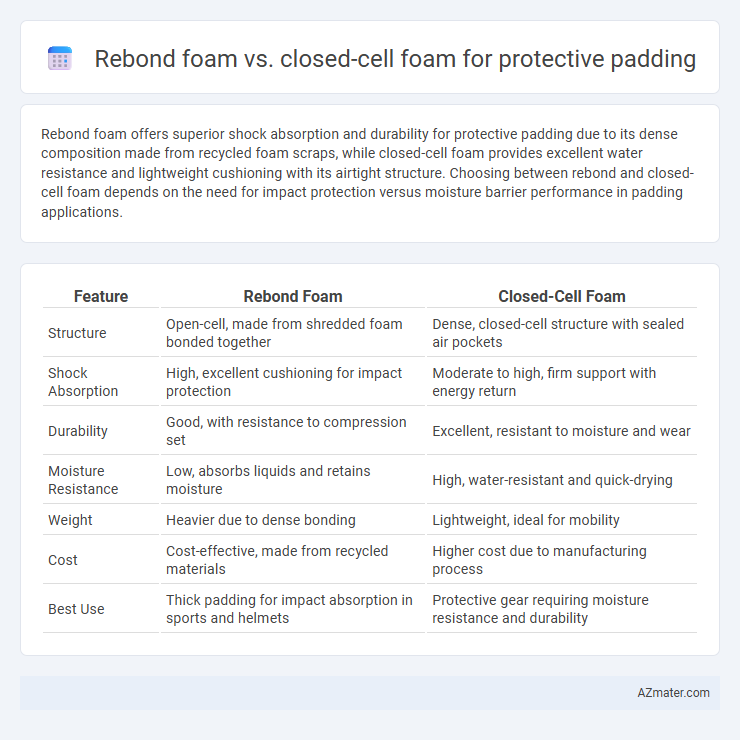Rebond foam offers superior shock absorption and durability for protective padding due to its dense composition made from recycled foam scraps, while closed-cell foam provides excellent water resistance and lightweight cushioning with its airtight structure. Choosing between rebond and closed-cell foam depends on the need for impact protection versus moisture barrier performance in padding applications.
Table of Comparison
| Feature | Rebond Foam | Closed-Cell Foam |
|---|---|---|
| Structure | Open-cell, made from shredded foam bonded together | Dense, closed-cell structure with sealed air pockets |
| Shock Absorption | High, excellent cushioning for impact protection | Moderate to high, firm support with energy return |
| Durability | Good, with resistance to compression set | Excellent, resistant to moisture and wear |
| Moisture Resistance | Low, absorbs liquids and retains moisture | High, water-resistant and quick-drying |
| Weight | Heavier due to dense bonding | Lightweight, ideal for mobility |
| Cost | Cost-effective, made from recycled materials | Higher cost due to manufacturing process |
| Best Use | Thick padding for impact absorption in sports and helmets | Protective gear requiring moisture resistance and durability |
Introduction to Protective Padding Materials
Rebond foam and closed-cell foam are key materials used for protective padding, each offering distinct performance characteristics. Rebond foam, created from recycled foam scraps bonded together, provides high durability and impact absorption, making it ideal for shock protection. Closed-cell foam, characterized by its dense structure and resistance to water and compression, excels in cushioning and providing a moisture barrier for protective gear.
What Is Rebond Foam?
Rebond foam is a type of cushioning material made by shredding and recompressing scrap foam pieces using adhesive binders, resulting in dense, durable padding ideal for impact absorption in protective gear. Unlike closed-cell foam, which consists of sealed cells providing water resistance and rigidity, rebond foam offers superior shock absorption and resilience by distributing force evenly across its structure. Its versatility and strength make rebond foam a preferred choice for applications needing durable and comfortable protective padding.
What Is Closed-Cell Foam?
Closed-cell foam is a dense, rigid material with microscopic sealed cells that prevent air and moisture absorption, making it highly durable and water-resistant for protective padding. This foam type provides superior impact resistance and cushioning by absorbing and dispersing energy, ideal for use in safety gear, sports equipment, and packaging. Compared to rebond foam, closed-cell foam offers enhanced structural integrity and long-term performance in demanding environments.
Key Physical Properties Comparison
Rebond foam offers high durability and excellent shock absorption with a denser, open-cell structure that provides superior breathability and cushioning, ideal for impact protection. Closed-cell foam features a rigid, waterproof structure with low water absorption and high compressive strength, making it highly resistant to deformation under repeated pressure. When comparing protective padding, rebond foam excels in comfort and energy dispersion, whereas closed-cell foam provides better moisture resistance and structural integrity.
Shock Absorption and Impact Resistance
Rebond foam offers superior shock absorption due to its dense, recycled polyurethane structure that efficiently disperses impact energy, making it ideal for protective padding in high-impact environments. Closed-cell foam excels in impact resistance by providing a firm, resilient barrier that prevents penetration and maintains structural integrity under repeated stress. When prioritizing cushioning and energy dissipation, rebond foam is preferred, whereas closed-cell foam is chosen for enhanced durability and moisture resistance in protective applications.
Durability and Longevity
Rebond foam demonstrates superior durability due to its dense composition made from shredded scrap foam bonded together, ideal for long-term impact absorption in protective padding. Closed-cell foam offers excellent resistance to water, chemicals, and compression but may degrade faster under repeated stress and environmental exposure. For longevity in high-impact protective gear, rebond foam is preferred for maintaining structural integrity over extended use.
Comfort and Flexibility Factors
Rebond foam offers superior cushioning and flexibility due to its open-cell structure, making it ideal for protective padding that requires shock absorption and comfort over extended use. Closed-cell foam provides excellent resistance to moisture and compression but tends to be stiffer, which can limit flexibility and reduce comfort during prolonged wear. Choosing between rebond and closed-cell foam depends on the balance needed between pliability for movement and firmness for impact protection.
Common Applications in Protective Padding
Rebond foam is widely used in protective padding for sports equipment and gym mats due to its high density and impact absorption capabilities, providing durability and comfort. Closed-cell foam, known for its water resistance and rigidity, is commonly applied in protective gear such as knee pads, elbow guards, and helmets, offering superior shock absorption and moisture protection. Both foams serve critical roles in cushioning and protection, with rebond foam favored for heavy-duty use and closed-cell foam preferred in environments requiring moisture barriers.
Cost and Availability
Rebond foam, made from recycled foam scraps, offers a cost-effective solution for protective padding due to lower manufacturing expenses and widespread availability in various densities and thicknesses. Closed-cell foam typically incurs higher costs because of its denser structure and specialized production process but provides superior water resistance and durability, making it less commonly stocked by suppliers. Availability of rebond foam is generally more extensive in bulk quantities, while closed-cell foam may require custom orders, affecting lead times and overall project budgets.
Which Foam Is Best for Your Needs?
Rebond foam offers excellent durability and energy absorption, making it ideal for high-impact protective padding where long-term performance and support are required. Closed-cell foam provides superior water resistance and insulation, suited for environments needing moisture protection and lightweight cushioning. Choosing between rebond and closed-cell foam depends on whether your priority is shock absorption and durability or moisture resistance and flexibility.

Infographic: Rebond foam vs Closed-cell foam for Protective padding
 azmater.com
azmater.com